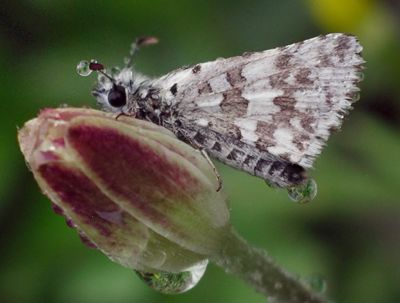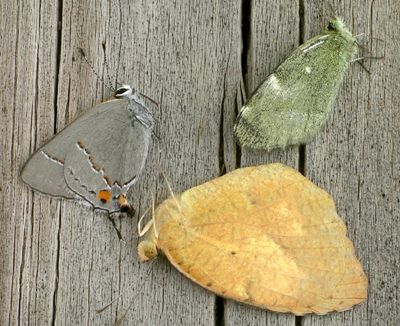
rather wet Common Checkered-skipper
But what about butterflies? Those delicate looking insects that float around flowers on warm sunny days do not just suddenly pop into existence at only optimum times. They must obviously survive through the rest of the not-so-great periods as well.
 rather wet Common Checkered-skipper |
Some people never give a second thought to the intricacies of nature, including such profound questions as "What do butterflies do at night?," "Where do butterflies go when it rains?" and "How do those lovely and delicate creatures survive the winter?" But the curious and inquiring mind DOES ask such things. One of the most delightful uses of our big brains is the asking, and answering, of questions.
Luckily, butterflies are very well-studied insects, and many aspects of their life histories and survival strategies are understood in great detail. The simple answer to what butterflies do at night is: sleep. This, of course, begs the question, "Where?" We are fairly large animals, so it is easy to forget that the vast majority of other species on our planet are much, MUCH smaller than us. For a good night's rest, we need a bed or at least a comfy place to lie down that will accommodate our 5 to 6 foot length. That's a lot of space. A butterfly, while it is not nearly as tiny as many insects, takes up only a fraction of that. It is relatively easy for a butterfly to find a cozy niche in which to hide for the night. Some butterflies simply roost hanging on a leaf, often on the underside. Some, like swallowtails, might even just sit right on the tops of leaves in a densely foliated place (our backyard is a favorite) from dusk to dawn. For relatively large and colorful insects, butterflies can be amazingly difficult to spot when they are not moving around. Those fragile looking wings are also not SO flimsy that they cannot stand being rubbed against leaves or sticks as a butterfly finds a secure hiding place.
The question about rain adds another hazard to the arsenal of environmental factors from which a butterfly must protect itself. Obviously, butterflies are not aquatic creatures. If they are dunked into water, they will drown. But the rainforests of the world are filled with not only rain, but myriad species of butterflies as well. So it can be surmised that the insects have solved the problem of staying dry pretty darn well. Leaves make excellent umbrellas, provided an animal is small enough, and this works for most butterflies. Any little crevice in a tree or rocky overhang can provide shelter. As long as they are not inundated by a torrent of water, the scales and hairs on a butterfly's wings and body will repel mist and small droplets quite adequately. Their waterproofing makes liquid simply bead up and drip off, allowing the butterfly's body, and breathing pores, to remain dry and functional. Although a cold and rather wet butterfly might look miserable by our anthropomorphic standards, they are simply waiting out the bad weather without the mental baggage that plagues humans.
 butterflies too cold to move |
There are some butterflies that cannot stand any freezing weather at any time in their life cycle. If they are an egg, caterpillar, pupa, or adult at the time the temperature falls below 32°F, they simply die. But many species CAN make it through cold times, including freezes, and there are a number of different strategies for this. It is true that all insects need the temperature to be above a given minimum for them to be active. When they are too cold, they cannot move about. The threshold, though, varies considerably for different species and sometimes even for individuals. Some kinds of butterflies actually produce chemicals that act as antifreeze, keeping their body cells from developing ice crystals that would kill them. Others can survive short freezes by finding microhabitats where the temperature is just a bit warmer. This accounts for why we see butterflies on a sunny, mild day in January right after we've had temperatures in the 20s. Some of our local species have winter color forms, often darker than summer individuals, to absorb the sun's warmth. Another tactic is to spend the winter as a caterpillar or pupa. These stages may be more freeze-protected by different chemistry, more insulation, or by digging or crawling into protected nooks. Some species even spend the winter as an egg.
The variety of solutions that butterflies have evolved to the problems of bad weather are intriguing. They add another layer to the fascinating study of these mesmerizing creatures, so beautiful and also so elegantly adapted to their environment.